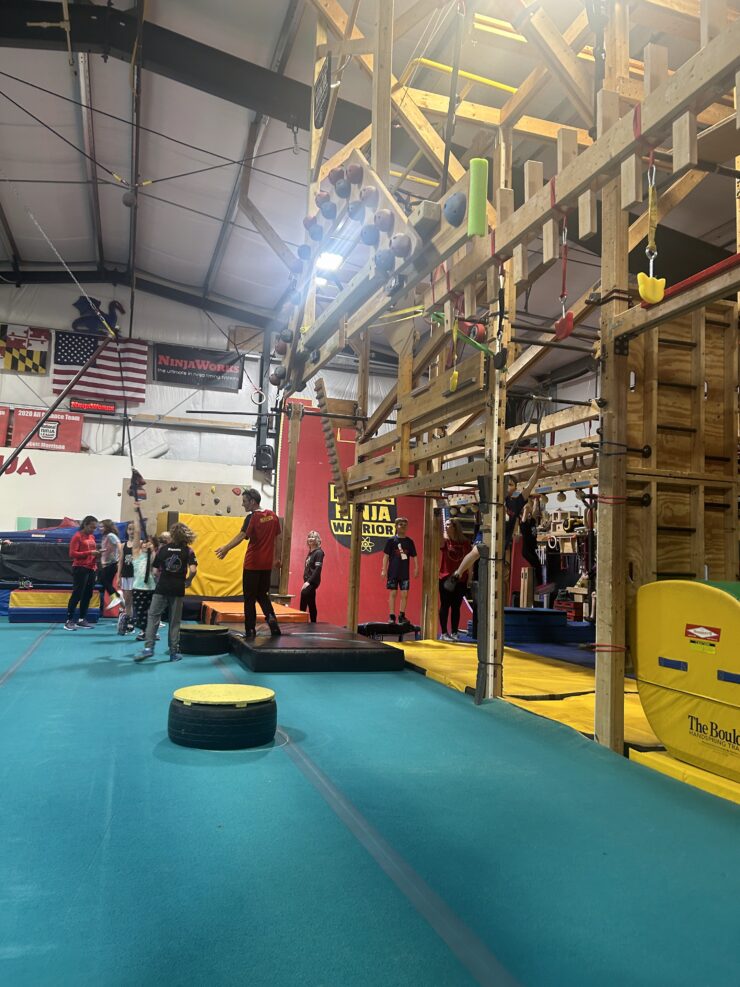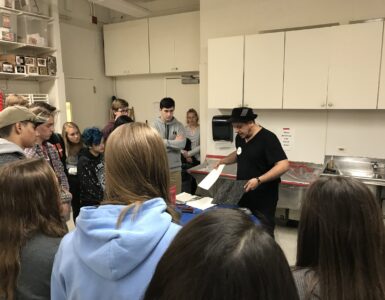By Matt Romano
Posing athletes dangle from Amy-Beth Topper’s ears as she sits in the crowd at her daughter Anabella’s “ninja” competitions. The blue and green colored jewelry mirrors the branding of the gym her daughter attends two or three times a week, depending on whether she has a competition. Topper enthusiastically makes the nearly two-and-a-half-hour drive from Maryland to Pennsylvania to take Anabella to Ninja Logic, even though there are closer gyms.
“I’ve not seen so many sports before where you come together and all the families are rooting for all of the kids, and the kids are rooting for each other,” said Topper. “They give their friends a tip on how to do it because it’s not about me versus you. It’s about me versus myself on the course. And they’re all encouraging of each other.”
Chasing competitions across the country, the Toppers recently drove six hours to the Movement Lab Ohio for the National Ninja League.
That kind of commitment to the sport is spreading.

Although ratings of the Emmy-nominated television hit American Ninja Warrior have dropped by half over the past decade, the number of ‘ninja gyms’ in the country has multiplied by 40 in that same time, according to Statista.
Michelle Warnky owns the Movement Lab Ohio, the gym that inspires both Amy-Beth and her daughter.
“I’m so excited to see women reaching down to the girls that are coming up behind them and building them up. I think that’s an amazing experience,” she said about Warnky.
In the show’s sixth season, Warnky made history as the second woman to climb up the fourteen-foot warped wall and advance to the city finals. Going into that season, no woman had ever achieved that feat. By the end of the season, five women had slammed the buzzer awaiting them at the top of the warped wall, punching their ticket to the city finals and forever changing the sport.
“It kind of like blew up overnight and went from this kind of like, no name show to everyone’s like, ‘[Did] you see about that girl that won?” recalls Warnky after Kacy Cantanzaro’s legendary 2014 city finals run aired.
The following year, the ninja community began to grow with leagues run by gym owners like the National Ninja League (now the World Ninja League) popping up. While the growing number of people arriving at the door of ninja gyms has been typically drawn by the reality show at first, these gyms can keep people coming back even when interest in the show is down.

In a business sense, customers get their money’s worth through a unique workout experience, with some gyms boasting thousands of interchangeable modifications to their arsenals of obstacles. Of course, they also allow kids and adults alike to live out their fantasies of competing on American Ninja Warrior through competition circuits like the World Ninja League. However, many people remain committed to their gyms due to a sense of community.
Traveling around the country to be part of a ninja community has been seen as weird at times, even for some of the ninja greats like Michelle Warnky. Warnky caught the ninja bug when the community was still in its infancy. While today many families like the Toppers are willing to drive from Maryland to Ohio for ninja, Michelle Warnky recalls people thinking she was a deranged fan for driving all the way from Ohio to New Jersey to train at a gym about fifteen years ago.
“So I ended up driving nine hours, and [the owner] thought I was crazy initially. He said he thought I was gonna pack up and go [stay] outside. He said he initially thought I was just like a super fan. He’s like, you know, no one would drive nine hours to do this or whatever at the time.”
Back then, a ninja warrior fan was synonymous with a reality television fan. Around twenty countries have run licensed adaptations of the Japanese show Sasuke, which originated the ninja warrior format. The first adaptation, American Ninja Warrior, began airing in 2009 on a small network called G4. Less than fifteen years ago, even the competitors did not see Ninja Warrior as a real sport.
“The landscape was more athletes that were kind of migrating from other sports,” says founder of the World Ninja League Chris Wilczewski who opened one of the first ninja gyms in the country where Michaele Warnkey first visited.
“I [was] like, this is something fun. I really enjoy doing it. I want to keep doing it, but I’m going to have to go get a nine-to-five job one day to keep the lights on. Like, there’s no way this thing keeps going. And much to my surprise, the community has since blown up,” says Wiczewski.

Through avenues like the World Ninja League, the 5-time American Ninja Warrior finalist and other innovators have found ways to fill the offseason with consistent revenue, sponsorships for athletes, and an organic culture apart from the show that keeps people populating the gyms. This takes a network of businesses. Many business owners are inspired by something more than profit, or even by mimicking a television show.
CEO of DGS Ninja Equipment, an obstacle manufacturing company, John Deary, used to design and produce gymnastics equipment. After being approached by a ninja competitor to engineer some equipment, he became passionate about the growing sport and now focuses primarily on producing ninja obstacles. The sport reminded him of the place gymnastics was in when he was a kid in the 70s and 80s, and it was taking off with American youth. Now, he helps support ninja events like the World Ninja League, hoping to see the sport grow in the same way.
In 2019, Deary reached out to Chris Wilczewski about expanding his new league.
“[I told] Chris, I can help you move this to, like we do in gymnastics, out to an arena and make this into a first-class event. Take all these little problems away. I will provide you with the steel and the obstacles and the mats. I will make this a very safe operation, like we do in gymnastics,” said Deary.
On mornings when Hartford, Connecticut, felt like 20 below zero with the wind chill, Deary and other World Ninja League affiliates unloaded seven truckloads of steel, mats, and obstacles. They assembled the WNL finals course in the XL Center Exhibition Hall, bringing in nearly 2,000 athletes from around the world. This event remains the largest ninja warrior competition to date, despite having no direct ties to American Ninja Warrior.
“All insiders kind of know that [American Ninja Warrior] is built for TV, super exciting. It’s built for building personalities and superstars, and we love all that aspect of it. It also dramatically helps us with new ideas and direction for the sport, all the new obstacles that are interesting,” says Deary.
“But with that said, the growth of the sport over the last seven years has been tremendous. I don’t think the sport is ever going to go away, even if there’s never a TV show.”
Ninja competitions continue to exist all across the world for all age groups. The phenomenon may appear to be a fad, a spinoff of gymnastics that is more marketable for television. However, the owner of Kinetic Ninja Warrior, Scott Morrison, believes that ninja is something he has been looking for his whole life.
“I’ve been doing ninja my whole life. As a kid, I built courses out in the woods, but in reality, it wasn’t a sport, so I became a gymnast.”















Add comment